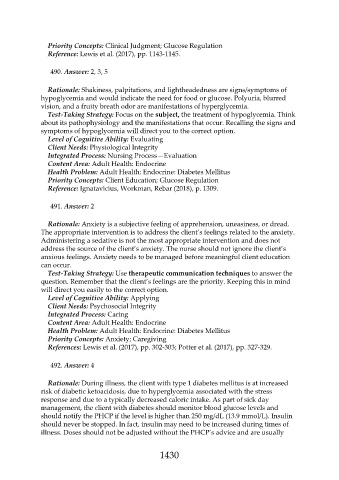Page 1430 - Saunders Comprehensive Review For NCLEX-RN
P. 1430
Priority Concepts: Clinical Judgment; Glucose Regulation
Reference: Lewis et al. (2017), pp. 1143-1145.
490. Answer: 2, 3, 5
Rationale: Shakiness, palpitations, and lightheadedness are signs/symptoms of
hypoglycemia and would indicate the need for food or glucose. Polyuria, blurred
vision, and a fruity breath odor are manifestations of hyperglycemia.
Test-Taking Strategy: Focus on the subject, the treatment of hypoglycemia. Think
about its pathophysiology and the manifestations that occur. Recalling the signs and
symptoms of hypoglycemia will direct you to the correct option.
Level of Cognitive Ability: Evaluating
Client Needs: Physiological Integrity
Integrated Process: Nursing Process—Evaluation
Content Area: Adult Health: Endocrine
Health Problem: Adult Health: Endocrine: Diabetes Mellitus
Priority Concepts: Client Education; Glucose Regulation
Reference: Ignatavicius, Workman, Rebar (2018), p. 1309.
491. Answer: 2
Rationale: Anxiety is a subjective feeling of apprehension, uneasiness, or dread.
The appropriate intervention is to address the client’s feelings related to the anxiety.
Administering a sedative is not the most appropriate intervention and does not
address the source of the client’s anxiety. The nurse should not ignore the client’s
anxious feelings. Anxiety needs to be managed before meaningful client education
can occur.
Test-Taking Strategy: Use therapeutic communication techniques to answer the
question. Remember that the client’s feelings are the priority. Keeping this in mind
will direct you easily to the correct option.
Level of Cognitive Ability: Applying
Client Needs: Psychosocial Integrity
Integrated Process: Caring
Content Area: Adult Health: Endocrine
Health Problem: Adult Health: Endocrine: Diabetes Mellitus
Priority Concepts: Anxiety; Caregiving
References: Lewis et al. (2017), pp. 302-303; Potter et al. (2017), pp. 327-329.
492. Answer: 4
Rationale: During illness, the client with type 1 diabetes mellitus is at increased
risk of diabetic ketoacidosis, due to hyperglycemia associated with the stress
response and due to a typically decreased caloric intake. As part of sick day
management, the client with diabetes should monitor blood glucose levels and
should notify the PHCP if the level is higher than 250 mg/dL (13.9 mmol/L). Insulin
should never be stopped. In fact, insulin may need to be increased during times of
illness. Doses should not be adjusted without the PHCP’s advice and are usually
1430

